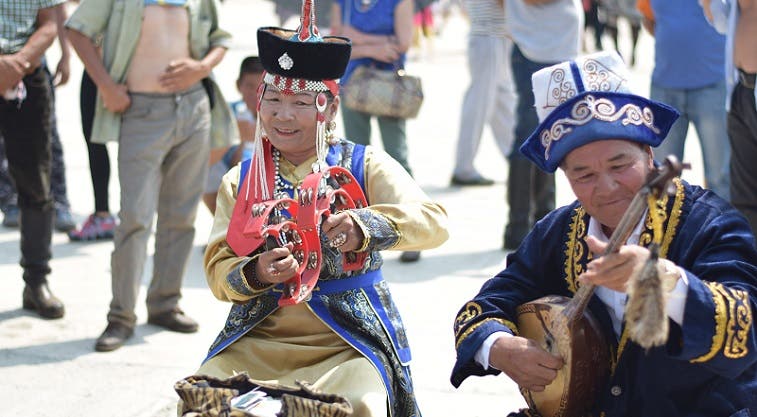Africa
Americas
Asia
Europe
Oceania
By Season
By Interest
By Group
Events and festivals in
Mongolia
Events and festivals in Mongolia
Mongolia is a country where even today one can appreciate the nomadic culture and the relationship of its inhabitants with horses, a source of wealth, and the center of Mongolian culture. Horses form part of one of the country's popular festivals. Find out all about it and take a piece of Mongolian history with you.
The Naadam Festival: religion, sport, and folklore
The most important festival in Mongolia is undoubtedly Naadam, which is also celebrated in the Inner Mongolian Autonomous Region of China. The festival has been designated as Intangible Cultural Heritage by UNESCO and revolves around three key areas: horse racing, Mongolian wrestling, and archery.
The origins of Naadam
It was in the 17th century that the three key sports began to be practiced after the completion of the Buddhist rituals that constituted the most important part of Naadam. In 1697 the games were dedicated to the leader of Tibetan Buddhism, Jebtsundamba Khutukhtu, and since then the festival has grown to what it is today.
Although initially Naadam was not celebrated on a fixed date, Mongolia's independence from the Quing Empire at the beginning of the 20th century saw the festival held in the last month of summer according to the lunar calendar.
But the evolution of the festival didn't stop there. Its symbolism changed after the communist revolution in 1921. The lunar calendar was banished and the Naadam was held from 11 July. It became a national holiday and served to commemorate the victory of the revolution and to honour the communist leaders.
Today, the political aspect of this popular festival has disappeared and Naadam has become a display of folklore once again. The start of the festival is broadcast on television and includes a major spectacle, with musical performances, dance and representations of historical events.
What Naadam includes today
Besides the concerts, dance performances, and historical tableaux, Naadam today revives sporting competition in the three basic disciplines: horse racing, archery and Mongolian wrestling. Although the most important of Mongolia's popular festivals is celebrated throughout the country, the place where you can enjoy it at its best is Ulaanbaatar.
ArcheryThe archery competition involves teams of ten people who must wear traditional Mongolian clothing and use the Mongolian bow. They shoot at a target from a distance of 75 meters (65 for women) and the winner is the one who comes closest to the bulls eye.
Horse racingThe stars of these races are undoubtedly the horses. In fact, the riders are usually children aged 10-13 who weigh very little. The races are held in the Mongolian grasslands and can be up to 30 km long. The participants sing gingos, or traditional songs, in preparation.
Mongolian wrestlingIn this type of combat the contestants wear shorts and a vest, which is where they can grab one another. They can only touch the ground with their feet and the first one to fall is the loser. This type of fighting has no set time limit and was traditionally only practised by men, although women are now taking part as well.
Tsagaan Sar or Mongolian New Year
The white month, the first of spring, is the date of the second of the great popular festivals in Mongolia. The end of winter and the beginning of spring are celebrated. The Tsagaan Sar is celebrated at the new moon at the end of winter, which means that this festival has no fixed date.
On the eve of the Tsagaan Sar, festive worship and prayers are held in Buddhist temples, after which the faithful make bonfires and burn small objects that are no longer needed and symbolize the sad moments of the previous year. Afterwards, people visit friends and family, who are congratulated on the new year and given gifts.
People also eat traditional foods, sing songs and take part in sports competitions at Tsagaan Sar.
Family gatherings are held in the home of the oldest family member and people usually wear traditional Mongolian clothes, which are renewed at each Tsagaan Sar because the tradition of the country is to welcome the new year with new clothes.
The Bituun
The Bituun is held in smaller family groups on the eve of Tsagaan Sar. The day is marked by lighting candles on the family altar. The candles symbolise the light of the road. As they are lit, the family holds their khadags, long, colourful fabrics. Three ice cubes are also placed on the threshold. This means that the horse of the god Palden Lhamo will have something to drink, because during the night this god visits all the houses. Festivities are finished by eating tsagaa, curdled rice.
Bituun celebrations are prepared a long time in advance, as Mongolians believe that the new year should be received with all their tasks done and all their accounts settled.
The Buryatia
This is the third day of Tsagaan Sar and the day when the Great Sacrifice is made. This ritual, related to shamanism, is performed in the courtyard of each house. A table is prepared with nine bowls of water and incense, and at night a fire is lit with smoke rising to the sky as an offering. This is how they worship the Seven Stars or Seven Elders.
Shamans perform the same ritual, but to make the water in the bowls sacred they place mirrors in it. Afterwards, they wash with it and thus protect and purify themselves. Tibetan lamas also hold a similar celebration.
Subscribe to our newsletter and join Exoticca GO
The best travel deals
Exclusive promotions
Expert travel tips
